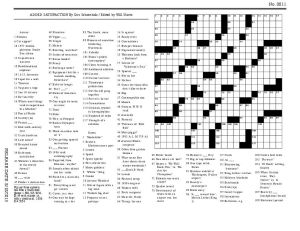

I loved crossing the Lawn every day for class when I lived by the Corner. I had my Bodo’s order down to a science, too: BLT on an everything bagel with onions, avocado, Swiss and sprouts. I certainly won’t forget taking occasional nighttime excursions to the McCormick Observatory, followed by late-night grub from the Castle or Crossroads. If I wasn’t feeling at home already, that was the difference-maker. Where do I begin? I guess I can’t not bring up my first-year hall’s Day 1 icebreaker, where I shyly revealed I wrote crossword puzzles for The New York Times, only to have another hallmate exclaim that he was an avid solver himself. How about favorite memories of your time at UVA?Ī. “Goes from Kyoto to Tokyo, say”: ANAGRAMS “Pac-Man was its ‘Man of the Year’ in 1982”: MAD MAGAZINE You’re opening up Pandora’s box here, but I’ll try to limit myself to my top five, in no particular order: Do you have any favorite crossword clues from over the years?Ī. Brain-crushing, ridiculous-looking theme-less puzzles are my favorites to create after all. Thus, my vote for “toughest day of the week to construct” is Monday, though I believe I’m in the minority amongst my colleagues. And while there are several tried-and-true theme types out there, the goal is for the puzzle to be fresh and exciting for the solver.

At The Times, where I review our crossword submissions, the most common reason for rejection is the puzzle’s theme not being quite interesting enough overall. More importantly, while it’s one thing to make a themed puzzle, it’s another thing to make a good themed puzzle. That said, themed puzzles can take various forms, so sometimes there may be crazy grid constraints involved in pulling off a novel gimmick.
#New york times first crossword editor full#
Not only is the grid daunting enough to complete, but it should be full of fun, interesting vocabulary throughout, with a minimal amount of short “crossword-ese” holding everything together. Meanwhile, a theme-less puzzle – run every Friday and Saturday in The Times – has mostly longer words and a more wide-open grid by nature. On the surface, a themed puzzle is easier to create once you’ve figured out your theme set and grid pattern, the filling is relatively easy (albeit tedious at times). Is it easier or harder to build a puzzle with a theme?Ī. I still remember crossing McCormick Road from my Echols dorm for those 1 p.m. When I got to IAN, for instance, I immediately wondered if there was anyone named Ian I could somehow tie to UVA, and then those Ian Frye field goals came to mind! Same with BIO, although my only class in Gilmer was CS 1110. When I clue an answer, I usually just sit there and think for a few moments before hitting up any search engines, dictionaries and whatnot. You might joke, but there’s definitely truth to this. Did you come up with all the UVA clues just based on your great memories of being on Grounds?Ī. That said, some of the difficulty can be ascribed to the fill itself: answers like the uncommon name VIGGO, the hard-to-parse GEN X/IN OT/IT’S LIT, and the tough-ish words CLAVE/UVEA/BOSC/ALVEOLI all add to a potential solving challenge. The puzzle I’ve made here has mostly Monday- or Tuesday-level clues, so it’s on the easy side, meant to be accessible to solvers of any skill level. The New York Times Crossword gets harder as the week goes on, with larger Sunday puzzles at about a Thursday difficulty. How does this UVA puzzle compare on the scale of difficulty with New York Times crosswords?Ī. You always want to tackle the patterns with the fewest options ahead of time, so you’ll know early if something needs tweaking.įor instance, at 16-Down, that initial O?S?E? pattern yielded only OYSTER, OUSTER, and OUSTED in addition to ON SPEC. That top-right corner, with those GO/HOOS/CORNERSTONE theme constraints, was the most challenging area … but it’s also where I began.

#New york times first crossword editor trial#
Out of all these steps, filling the grid takes the longest, because there’s so much trial and error.


 0 kommentar(er)
0 kommentar(er)
